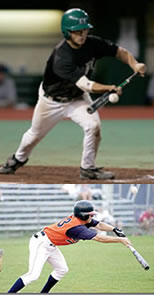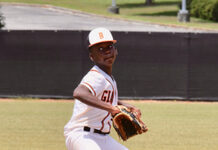Bunting is an often overlooked, yet vital skill for the complete hitter. Proper execution of this skill can be critical to a team’s success. Advancing runners into scoring position with a sacrifice bunt makes a world of difference in a tight ballgame. So can laying down an unexpected drag bunt single against an especially tough pitcher. Both types of bunts put pressure on the defense and cause reactions that can benefit the offense. The bottom line is that teams that execute the bunt properly will win more of those close 1-run or 2-run games.
Whether your team plays “small ball” or relies heavily on home runs and extra base hits, bunting should be part of every player’s daily practice. The reason for this is because you actually are practicing hand-eye coordination at the same time you are practicing your bunting technique. Let’s take a look at the proper technique for both the sacrifice bunt and the drag bunt.
 |
|
2 examples of bad bunting technique. Keep the bat head up, and don’t lunge.
|
The Sacrifice Bunt
First off, it is a good idea to move up in the box when executing the bunt. This gives you a little more fair territory to work with. Starting in a normal batting stance, the hitter rotates their back foot so that their body is squarely facing the pitcher. At the same time, the top hand should start sliding up the barrel of the bat and moving it into proper position. The top hand should end up about halfway up the barrel, with the bat positioned comfortably between the thumb and index finger. The batter should be in a balanced and comfortable position, with the knees bent. He should also be leaning forward with most of his weight on the front leg.
Bat Angle
The angle and positioning of the bat is critical, and this is where many players’ bunting mechanics break down. The bat should be held out in front of the body, with both elbows bent. The barrel of the bat should be positioned pointing upwards at about a 45 degree angle, at the top of the strike zone. The bat should also be slightly angled forward, again at around a 45 degree angle. Having the bat in this position accomplishes several things:
- It makes it much harder to pop the ball up, the cardinal sin of bunting.
- The angle of the bat is geared toward the left side of the infield, where you want the ball to go in most cases.
- By having the bat head at the top of the strike zone, the hitter knows that if he has to go up to reach the pitch, it is not a pitch he should be attempting to bunt. READ MORE
















